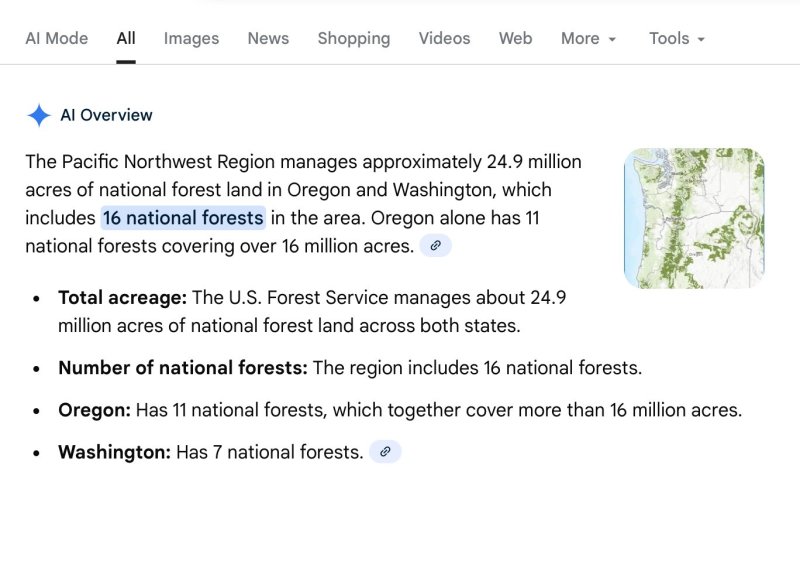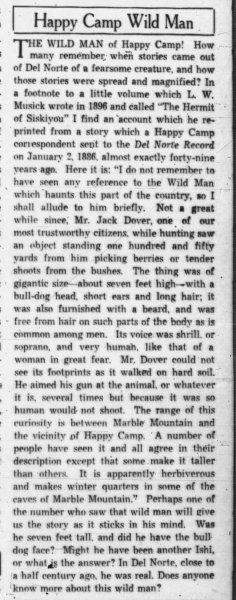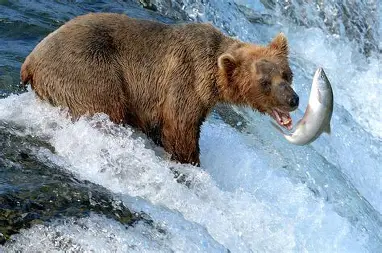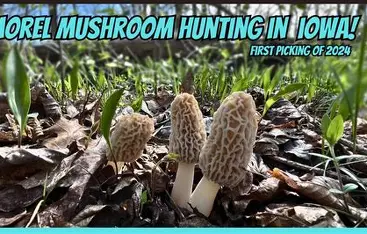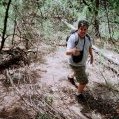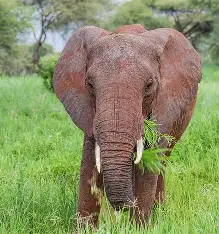All Activity
- Yesterday
-
You’re hard to pin down. But since we have established that Bigfoot doesn’t need to leave the forest to forage or graze it you like? They have 25 million acres to do it in, just in Washington and Oregon alone. And that’s not counting state land or timber company property. Just National Forest. Also we do have reports of them seen fishing. But salmon runs in the PAC NW are not what they used to be. Grand Coulee dam alone wiped out a large swath of salmon bearing streams and rivers. https://alaskabeacon.com/2025/08/19/salmon-extinction-in-motion-in-washingtons-and-oregons-snake-river/
-
I happen to know where that pic was taken. It (and other such waterfalls along the Alaska coast) are almost all now within either national parks or other classified areas with human behavior restrictions because brown bears congregate there. There are a few in southeast Alaska like that where black bears congregate, too, but mostly under the cover of thick vegetation. There are lots of rivers and creeks where bears fish. They might not do so in congregations like McNeil River or Brooks Camp, but they're there. One rarely sees them because they'll come out at night when we go to bed. I'm thankful for that. I let them have the night. I think sasquatches have creeks where they like to fish, but they're almost assuredly in locations devoid of man. I think they know the dangers of mankind, and their priority is to avoid us. They do so even better than the bears.
-
California 1886 - Hunter Has Wild Man in His Sights, Can't Shoot
Trogluddite posted a topic in More Historical Newspaper Archives
Published in the Oakland (CA) Tribune on January 05, 1936 and mentioned in the Forums at least once. However, the sighting is mistakenly dated to 1936 (the year of the newspaper article) when, in fact, it occurred in 1886. -

‘Bigfoot Took Her’ Review: When Sasquatch Was the Suspect - The Wall Street Journal
BFFbot posted a topic in News Articles
‘Bigfoot Took Her’ Review: When Sasquatch Was the Suspect The Wall Street JournalView the full article -

‘Bigfoot Took Her’ Review: When Sasquatch Was the Suspect - The Wall Street Journal
BFFbot posted a topic in News Articles
‘Bigfoot Took Her’ Review: When Sasquatch Was the Suspect The Wall Street JournalView the full article -

‘Bigfoot Took Her’ Review: When Sasquatch Was the Suspect - The Wall Street Journal
BFFbot posted a topic in News Articles
‘Bigfoot Took Her’ Review: When Sasquatch Was the Suspect The Wall Street JournalView the full article -

‘Bigfoot Took Her’ Review: When Sasquatch Was the Suspect - The Wall Street Journal
BFFbot posted a topic in News Articles
‘Bigfoot Took Her’ Review: When Sasquatch Was the Suspect The Wall Street JournalView the full article -

‘Bigfoot Took Her’ Review: When Sasquatch Was the Suspect - The Wall Street Journal
BFFbot posted a topic in News Articles
‘Bigfoot Took Her’ Review: When Sasquatch Was the Suspect The Wall Street JournalView the full article -

‘Bigfoot Took Her’ Review: When Sasquatch Was the Suspect - The Wall Street Journal
BFFbot posted a topic in News Articles
‘Bigfoot Took Her’ Review: When Sasquatch Was the Suspect The Wall Street JournalView the full article -

‘Bigfoot Took Her’ Review: When Sasquatch Was the Suspect - The Wall Street Journal
BFFbot posted a topic in News Articles
‘Bigfoot Took Her’ Review: When Sasquatch Was the Suspect The Wall Street JournalView the full article -

‘Bigfoot Took Her’ Review: When Sasquatch Was the Suspect - The Wall Street Journal
BFFbot posted a topic in News Articles
‘Bigfoot Took Her’ Review: When Sasquatch Was the Suspect The Wall Street JournalView the full article -

Trick-or-treaters search for candy and Bigfoot this Halloween - Monroe Evening News
BFFbot posted a topic in News Articles
Trick-or-treaters search for candy and Bigfoot this Halloween Monroe Evening NewsView the full article -
Not really. I talked about the need to "graze" based on the limited diet would increase the need for Bigfoot to expand its food search area as a practical matter. Any time where Bigfoots needs can't be met locally it would force bigfoot to be on the move until its needs can be met. We don't know the specifics of those needs. "Grazing" as a concept means the active searching or Movement for food esp. plant foods. This doesn't mean we are talking about cows eating grass out in the open field in Nebraska. It's conceptual. It's simply a matter of degree. If we want to say Bigfoot eats fish (and I imagine they do) I do have to wonder, why they are not spotted around salmon streams on a regular basis. Other than small numbers of bigfoot in existence, I can't think of any other major reason. There are plenty of food available for the taking. Stuff grows IN the Forrest for anyone who hasn't been made aware. Since most issues of Bigfoot are conceptual (since we don't have a body on a slab to study) BFF postings on the issues are meant to be conceptual. If what Bigfoot needs is close by, bigfoot is likely to stay close by. If not, Bigfoot would have to be on the move. If Bigfoot's has a very limited diet, Bigfoot has fewer options to fulfill that diet. If Bigfoots diet is more flexible it should be easier to meet it's food needs. It's well and good if there are berries and mushrooms available. This assumes Bigfoot would eat them and can eat them. If not, it's useless to the direct needs of bigfoot.
-
^Good example, and yes lots of reports from pickers of all kinds. BTW, there's plenty to learn about behaviors from select podcasts. I recently listened to an interesting report from a mushroom picker who was picking to make money, and had hired a whole crew to help. They got an aggressive confrontation in which the man's dog tried to attack and was killed by the big guy. I got the impression that the people had really messed up by overharvesting. That one starts about 50:00 in the first video. The second one I haven't entirely listened to but the title is on-topic.
-
You talked about Bigfoot needing to leave cover and be out in the open to forage. That’s a false assumption. I have picked huckleberries under a lodgepole pine canopy in Ferry county. Stuff grows IN the forest. That’s my statement. And yes? There are plenty of reports of berry pickers encountering Bigfoot. And yes there is a seasonality to it. https://www.bfro.net/GDB/show_report.asp?id=20802
-
They do. Just not as often as we'd like. This is partially because there are very few sasquatches and the sasquatches have taken up nocturnal or other behaviors to minimize contact. For example, bear encounters in berry patches occur in Alaska, but not nearly as often as they could, considering there are @ 140K bears, less than 1 million people, and an area over twice the size of Texas involved..............as well as the fact that people don't pick berries for a good 16 hours of the day.
-
Shouldn't these human mushroom pickers encounter Bigfoot doing the same thing? That's my point. My issue isn't Bigfoot failing to eat these things. If Bigfoot was exclusively limited in the diet, shouldn't we expect the see Bigfoot out there hunting seasonal berries or mushrooms right along with the people as a regular occurrence? Here in Iowa (and I don't pretend to know the PNW) mushrooming is done every late spring. It's seasonal. If we happen ot have Bigfoot here AND if Bigfoot has a diet high in these mushrooms due to its limited diet, we should have common bigfoot sightings during this time? I am thinking Bigfoot diet is a diverse diet based on whatever happens to be around him. Bigfoot is a big engine to feed.
-
I remember the story! Cliff has them on his website. https://cliffbarackman.com/home/projects/footprint-database/database-contents/2005-priest-river-id/ I still say a snow bike has the potential to follow a snow trackway to its conclusion. And if we don’t want to kill it? Then a crossbow with a biopsy dart is the next best thing.
-
Berries and mushrooms grow in the forest. Think about human mushroom and berry pickers heading up into the mountains to harvest them and encounter Bears doing the same thing. It’s not a higher risk for Bigfoot either.
-
Texas 1854 - First Jack County Residents Find Wild Man
Trogluddite posted a topic in More Historical Newspaper Archives
-
We've had a fair amount of rain, especially the horrible flooding in July.....not used to finding so many interesting prints, still have a bunch to post from the last several months, the last one is an oldie in Limestone. Some of the pics have multiple prints & sizes.
-
If bigfoot constantly has to search for berries and mushrooms, Bigfoot will have to be doing more grazing constantly searching for food. More grazing means more exposure out in the open. This should mean higher risk of being seen. My guess is Bigfoot eats meat in the form of what it can find. Whatever living thing one can find in a creek bed is on Bigfoot's menu. Eating meat means filling up Bigfoot sooner with less effort. This matches the idea we don't see heards of Bigfeet running around looking for food all day. There are a lot of large animals who are herbivores. They tend to be grazing all the time. This does show though Big animals can find food and fill their needs only on fruits and veggies and plants. I just think it makes more sense Bigfoot being a mixed diet animal who benefits from eating all of it. Here is what that plant-eating Elephant does for food: "They normally graze between 15 – 20 hours per day, which is why large spaces are essential for allowing elephants to eat for the amount of time and get the amount of nutrition they would in the wild. They can ingest approximately 150kg (330lbs) of natural browse in a day." Looks at a typical salad some 200lbs adult male might eat for dinner (hopefully one that will fill them up) "A large salad can contain a wide range of calories depending on its ingredients: 200 to 700 calories for a simple garden salad to richer varieties like Caesar or Cobb salads. Some estimates suggest it can range from 370 to 850 calories based on specific ingredients and their quantities. "
-

Something Strange In 3I/Atlas Image Has Us Asking Questions #3iatlas #podcast
BFFbot posted a topic in Wild & Weird Radio
Something Strange In 3I/Atlas Image Has Us Asking Questions #3iatlas #podcastView the full article -
Canada 1936 - Farmer Brown's Boy - Tirademan!
Trogluddite posted a topic in More Historical Newspaper Archives
Published in the Saint John, New Brunswick Telegraph-Journal on April 22, 1936. It sounds like an interesting story, but as Tirademan pointed out, it is clearly a work of fiction meant for kids. -
My view is there are not many of these things out there ( less in your area, maybe 3 from border to Newport ) and I am convinced they come down right to a place they find " tolerable " and skirt along river corridors just above normal human access or use. The cycle they likely follow in the colder climates must be large and in thick timber so the ice plate deposits from melt and refreezing cover a lot of their recognizable prints and destroy details that give it away. I believe Grassman58 on youtube has found a few suggestive trackways over the years. Being close to edge habitat for deer, elk and remote valleys with running waterways would be priority. My only guess would be they reduce activity massively, perhaps have some caches and operate at on deficit until snow breaks up. I would not be surprised to find out one day they can reduce their metabolic rate in the colder months, some form of torpor but not true hibernation. I have heard some far north native tribes are reported to have this ability to a degree. I could see them taking advantage of shafts and shallow cave systems but I want to know why we don't find preserved tracks in the cave floor if that is the case. There are a variety of snow trackways from nearby your area and they tend to occur around periods of bad weather, one I remember was about a guy found a set of prints that crossed his property near the Priest River area and they led up hill to a mangled deer completely disemboweled and meat pulled from the body, he noted bloody butt marks, hand prints and knee prints in the snow around the carcass. This was back around 2008 or something, the tracks went up hill into timber through some nasty thick regrowth and the guys could not follow as the snow was bucketing down and night was falling. I met the guy and heard his story first hand at the Klondike Tavern in Laclede, WA just before he moved to Alaska ( Thorn Bay ). I heard a similar story about someone finding snow prints up Dry Canyon Rd in 2014, tracks crossed the road and went up hill toward the north to south ledge above the river, I tried to get in touch with the witness but he was native and did not want people to think he was crazy so he would not get in touch with me. I also got a report of a snow trackway behind Freeman Lake in February of 2017, guys brother told me a little about it but said that he would not talk to anyone as he was a totally recluse. The other factor is that people out in these more harsh environments and remote properties are generally tight lipped and don't like to share. They know stuff and you don't and they want to keep it that way. To just touch on the coast for a second, I have loads of data here that seems to indicate they are still moving through their core habitats and visit throughout the year, as noted in another thread. They seem to drop below the holding snowline and hang out in wet thick crap on the edge of big timbered slopes that border a variety of habitat types and resources, they then cycle through a kind of loop along preferred paths over the course of a couple weeks and return to the starting point. Outside of the coastal states, your guess is as good as mine honestly but we still get the occasional snow trackway in the dead of winter so my question would be, how is it happening if they go coastal? This where I am with the question and that is what I have come across in my 4 years investigating the Selkirk area and it did not add up to much. I 100% agree, if you can solve the winter strategy in snow holding areas then you can really move the ball forward.


